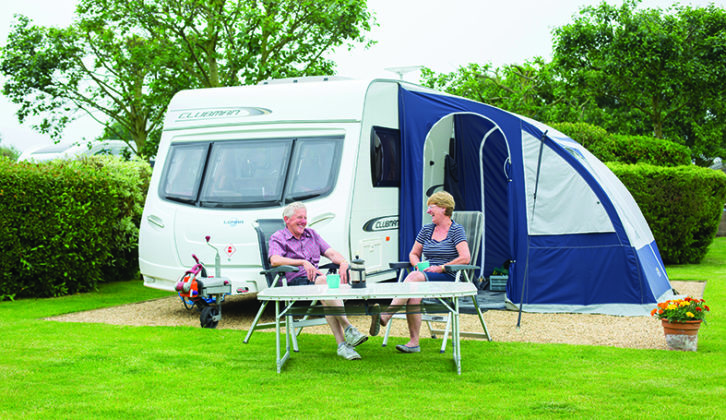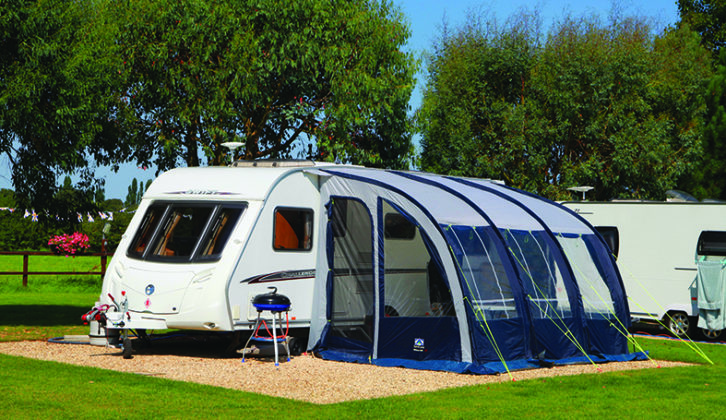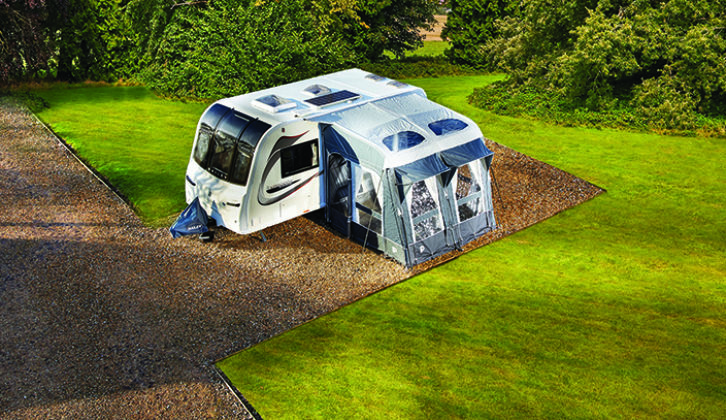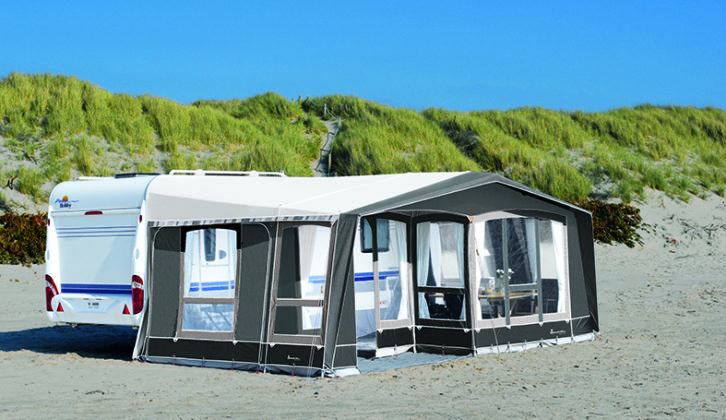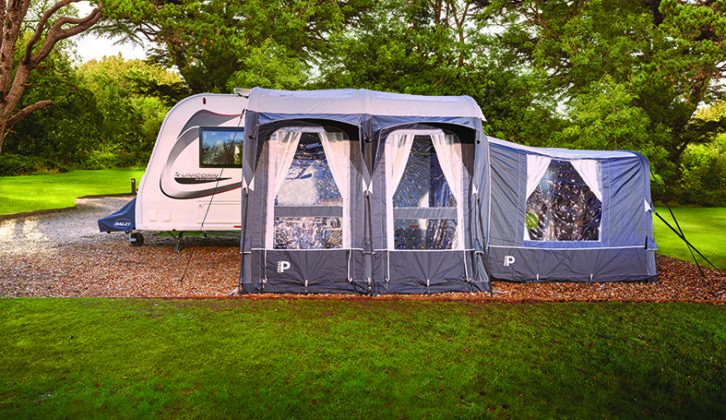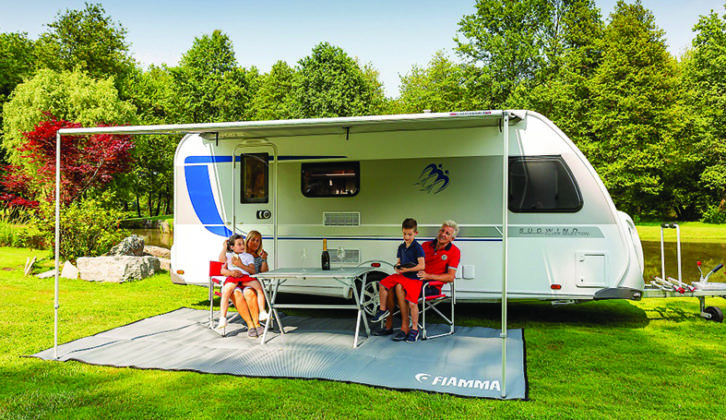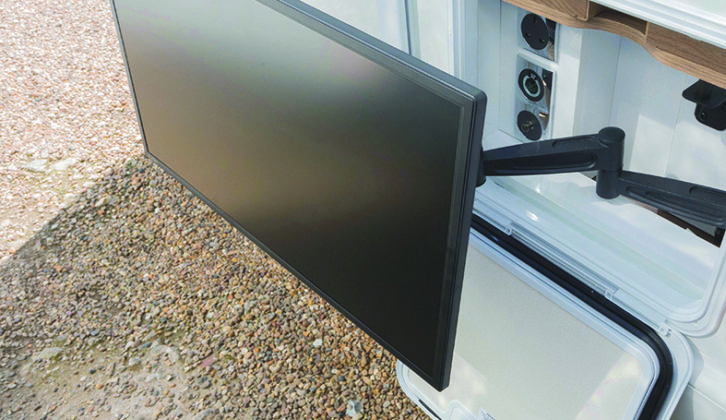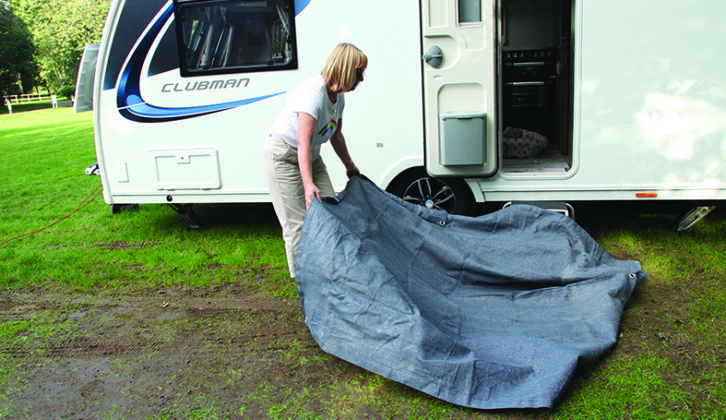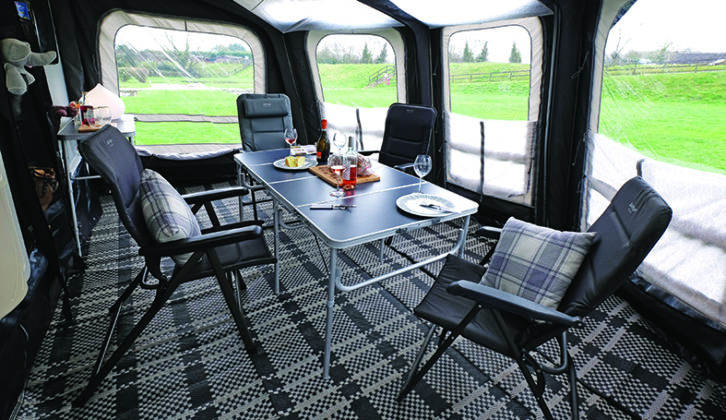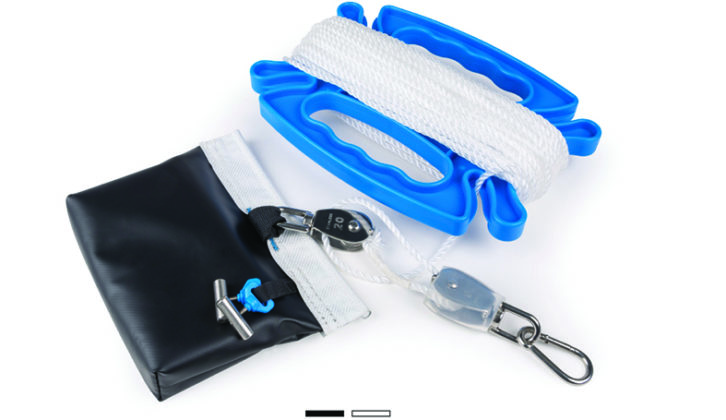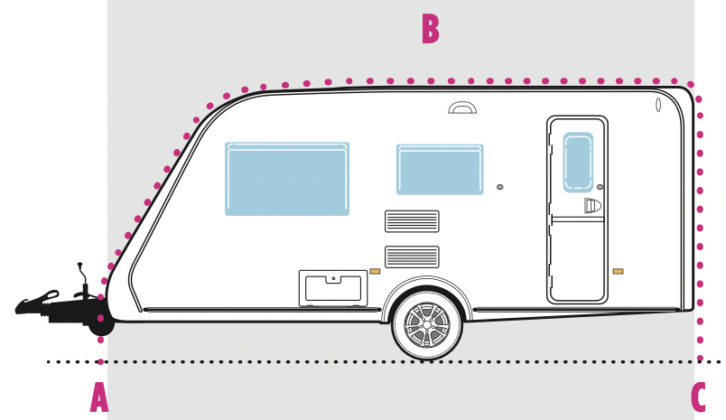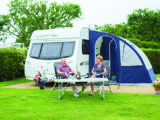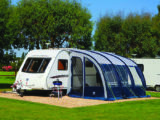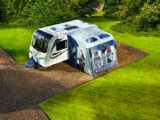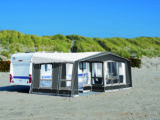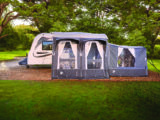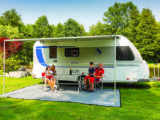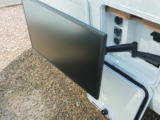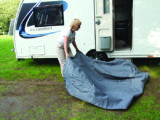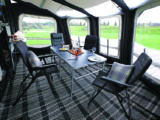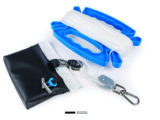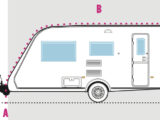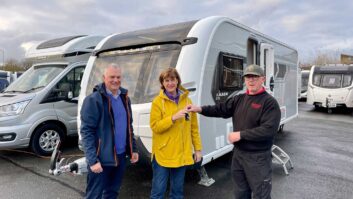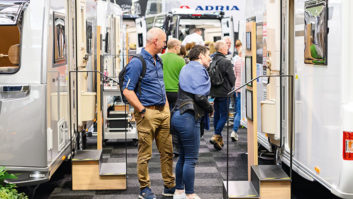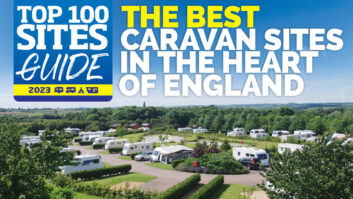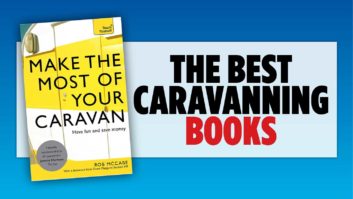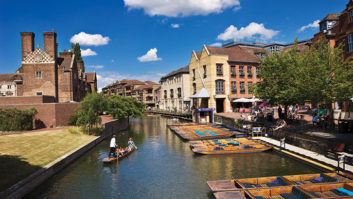One of the main attractions of the caravanning lifestyle is the hygge effect: the sheer cosiness of settling down in a small, warm space, somewhere that you feel safe and secure.
This is indeed a wonderful thing, but many families find they need a bit more room for convenient caravan living – for accommodation, storage or practical daytime activities. They could buy a bigger caravan although that might be more challenging to tow and store, and there is a better solution that’s simple and relatively cheap. The answer is a caravan awning. Awnings are fabric structures that attach to the side of your van, delivering extra usable space to suit your requirements.
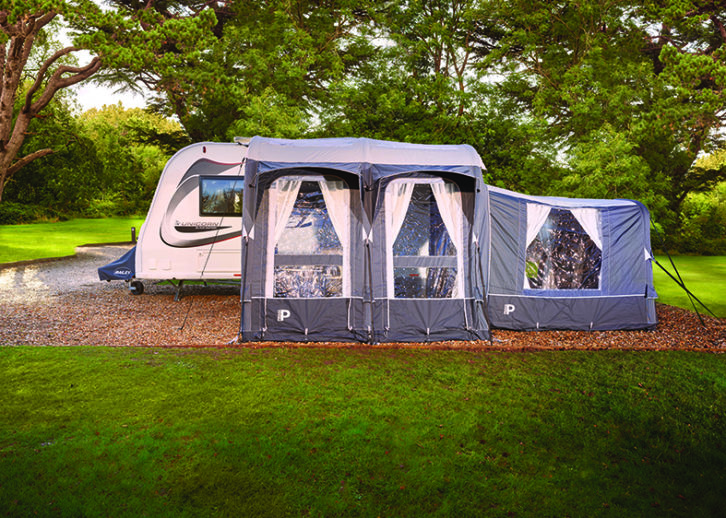
Caravan awnings are available in a huge range of sizes, split into two groups: full awnings – which cover the entire side of the caravan (often doubling your living space), and porch awnings, which cover a section of the side of the tourer.
Porches might be as small as one to two metres in width – providing an ‘airlock’ to stop the weather getting straight into the van when the door is opening, and a boot room – or as big as four or five metres of flexible space, for living, dining, storage or sleeping. Many modern awnings also feature the option of add-on annexes, which make excellent extra bedrooms.
Costwise, new awnings can vary from £200 to £3000+, and you very much get what you pay for. As with most products, cheap imports are available, although for longevity, and build and materials quality, we would avoid them and go for something at least mid-market.
That means a minimum £300 to £600 investment. This will get you a quality product from an established brand, which should easily last five to 10 years if it is properly used, stored and maintained.
If your budget doesn’t stretch that far, however, consider seeking out a secondhand awning from a recognised brand on selling sites such as eBay or Gumtree. Time your purchase right and you’ll find there are some amazing bargains to be had – but only buy from trusted sellers with good levels of positive feedback.
As I write, I’m looking at a SunnCamp Air awning being sold by a private seller on eBay. It looks great and is priced at £140, but the image is from the SunnCamp website (just cropped), the seller has zero sales or feedback and there’s no product description. This doesn’t mean that it’s a dodgy deal, but it does make me cautious. Personally, I would avoid any seller with less than a few dozen positive feedback reports. Interestingly, the same product is available new from reputable stores online, with prices from £109 to £255 – so shop around!
Air or pole?
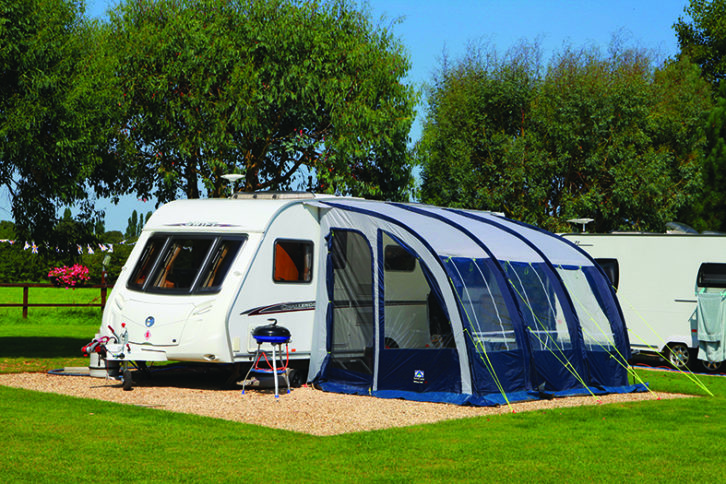
So how do you choose a caravan awning? In the past decade, there’s been a revolution in awning design, in the form of inflatable air awnings. These have actually been around since the 1950s, but modern materials technology means they are now a viable and extremely practical alternative to pole awnings.
Air awnings feature strong inflatable tubes, which, once blown up to the correct pressure, are incredibly rigid and durable. The benefit is that rather than fighting with a huge bag of (often) heavy steel poles, which all look alike, you now simply attach a manual or electric pump to the valve on the awning (there’s usually one or two) and then start pumping.
Within a minute, the awning will begin to take shape, and in less than two, it will be totally inflated. This process is especially advantageous when it’s being carried out in the rain, because a well-drilled awning builder can have the awning up and fully watertight in about five minutes.
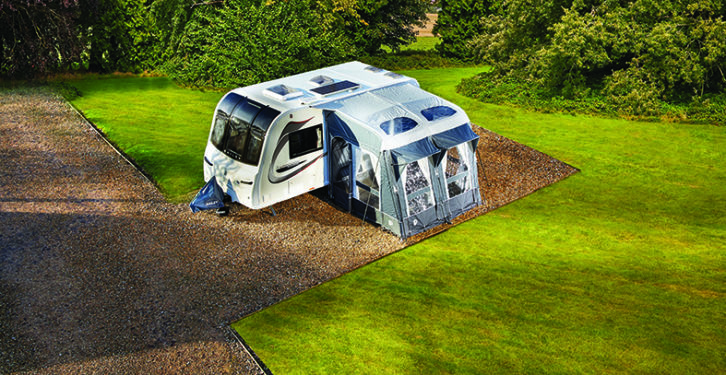
The other benefits of air awnings are that without the poles, you typically save a significant amount of weight – often 10kg or more. There’s no cumbersome pole bag to transport, and you’re much less likely to bash or scratch the side of your beloved tourer if you’re not waving steel tubes around all over the place.
A quality pole awning still has its place, of course. Nothing looks quite as good as a properly erected pole awning, and they are able to withstand the very severe weather that might result in an air awning buckling or flexing. And even the best air awning might need a top-up of air from time to time. That means we would also recommend a pole awning for seasonal or longer-term pitching. Finally,. pole awnings are available with composite/carbon fibre poles, which are strong and light and help mitigate some of the weight disadvantage.
Choosing an awning

Your eventual choice of caravan awning will depend on the following factors:
Size
How much additional space do you need? Bigger isn’t always better, especially when you consider it has to be transported, carried, unpacked, erected and stored. In fact, my advice would be to buy the smallest awning you can comfortably get away with to do the job. The largest awnings can weigh 40kg or more, while a usable one can weigh half that. Older and less mobile caravanners will find an air awning a revelation!
The A-measurement
Full awnings come with the all-important A-measurement. This is the distance (in centimetres) from the ground, up to the awning rail, all the way around the rail, then down to the ground at the other end. Your caravan’s tech spec should include this dimension, although you might have to measure it yourself. Do make sure that you know this measurement when you go shopping for a full awning.
Size conversion chart
Some caravan awning brands convert the A-measurement into a size number. Your awning dealer will advise you about this, and if you’re buying privately, they are listed in the panel below.
What size awning do you need?
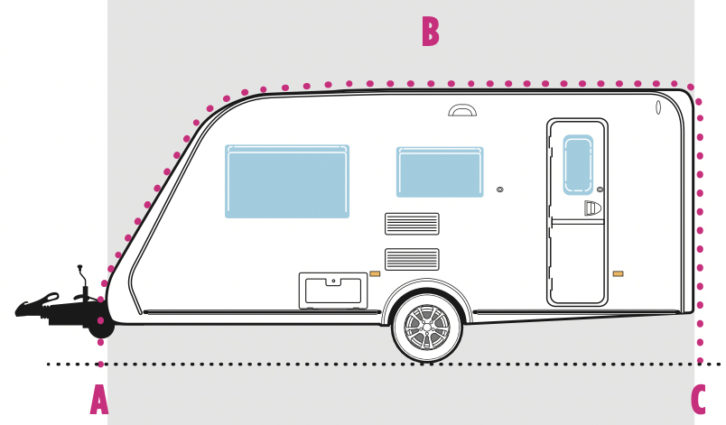
Measure your caravan as shown in the diagram below. The measurement (in pink) from ground to ground (A-B-C) can then be checked against the chart to give you your correct awning size.
Size – A-measurement (A-B-C in cm)
- 4: 725-750
- 5: 750-775
- 6: 775-800
- 7: 800-825
- 8: 825-850
- 9: 850-875
- 10: 875-900
- 11: 900-925
- 12: 925-950
- 13: 950-975
- 14: 975-1000
- 15: 1000-1025
- 16: 1025-1050
- 17: 1050-1075
- 18: 1075-1100
- 19: 1100-1125
- 20: 1125-1150
Style
Air or pole? Full or porch? I reckon that an air-filled porch awning is by far the easiest to store, transport and use. But if you need strength and permanence, you should definitely consider the traditional pole option.
Matching your van
If you choose a porch awning, buy a size that works with the dimensions of your caravan and the position of doors and windows. Ideally, you don’t want the awning side cutting across a window, preventing it from opening. Likewise, you don’t really want any ancillaries (heating, fridge and so on) venting into the awning (pick a caravan with the heating, fridge and oven opposite the door).
Brand
Like any other product, cheap imported awnings are available, but we would advise choosing one from a reputable brand with history in the market, and a company that is contactable in case of problems.
The Club effect
The major caravan clubs have strict rules about pitching, and if you’re a regular Club site pitcher, you’ll want to stay within the guidelines. Check with the Club site before you visit if you have an awning that you believe might be in danger of infringing on these rules.
Roll-out awnings
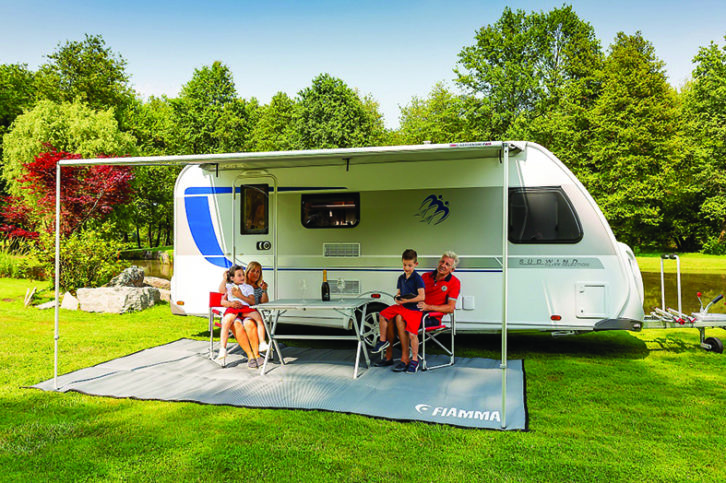
These excellent wind-out ‘shades’ are allowed on Club sites’ non-awning pitches, so long as they don’t break the three-metre rule (again, you should check with the specific Club site before travelling). This might not be the case if you add the side panels, however. For those who are planning to tour in hotter climes, they can be an excellent option.
Take a look at our best sun canopy for a caravan guide to see our top picks on the market.
Materials
Awning materials vary widely in strength, water resistance, cost, opacity, longevity and looks. While all awnings might appear similar, the materials used make the single biggest difference, and this will generally be reflected in the price of the product.
Brands such as TenCate specialise in awning materials. Polyester and polyvinyl alcohol coatings are often considered the best, with a single-coated material ideal for awning walls, and a double-coated fabric more suitable for awning roofs.
Design
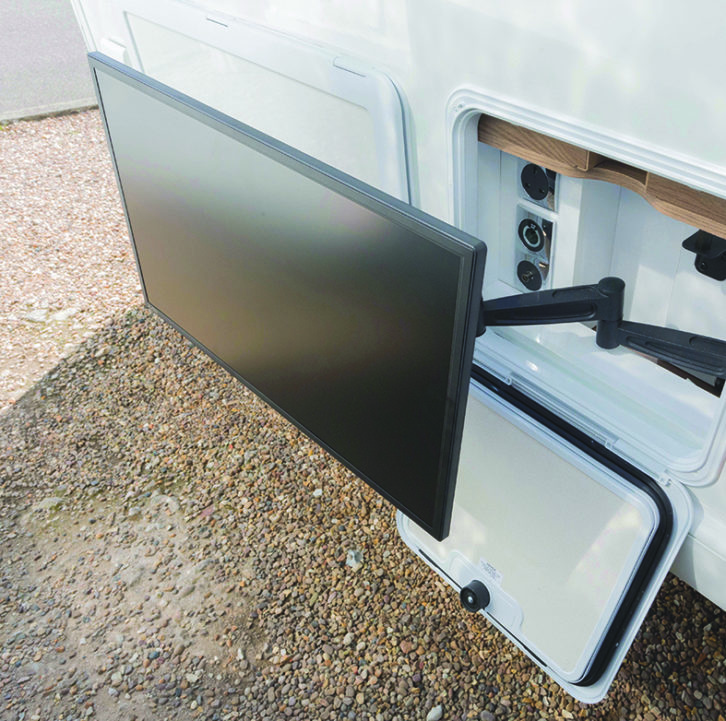
Beyond the space that your awning offers, do you prefer lots of window panels, and therefore a light and airy interior, or do you want more privacy?
Would you like a front roof extension, which you can stand under to take your boots off in the rain, and how about the option to add bedroom extensions?
The quality of the zips, Velcro fixings and guy ropes/storm straps and so on are also crucial elements. For example, some awnings offer fluorescent and luminous guy ropes to help prevent falls in the dark. All of these things need to be factored in.
Buying
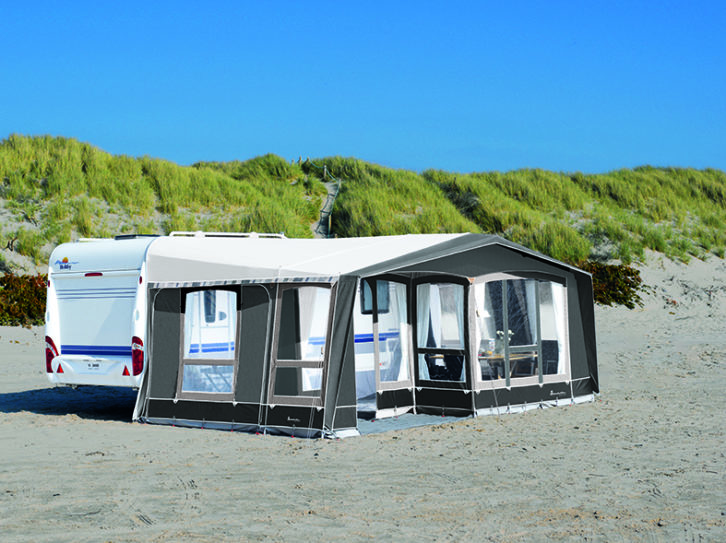
Many caravan dealerships offer excellent awning ranges for sale on site. They will also have a resident expert to advise you on the best awning for your needs.
Choose the right awning for you, and then do a quick price comparison to ensure the deal is good. Most vendors will be open to a bit of negotiation, especially if you’re spending a significant amount of money. At the very least, you might find you get a few handy extras thrown in.
Big-name brands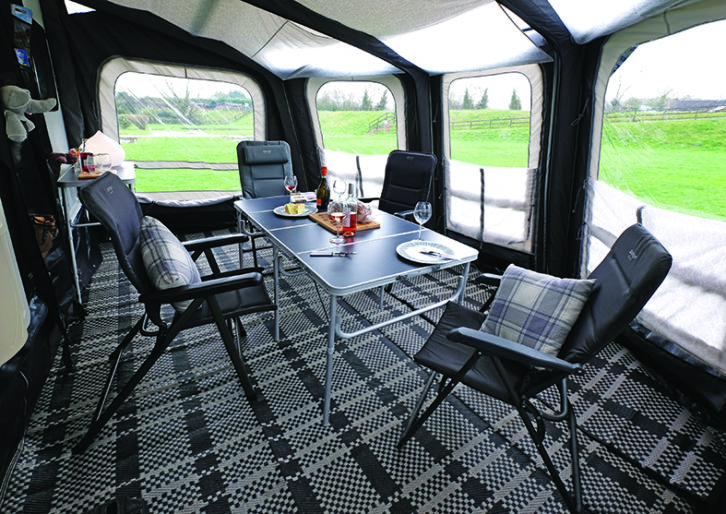 |
Building an awning
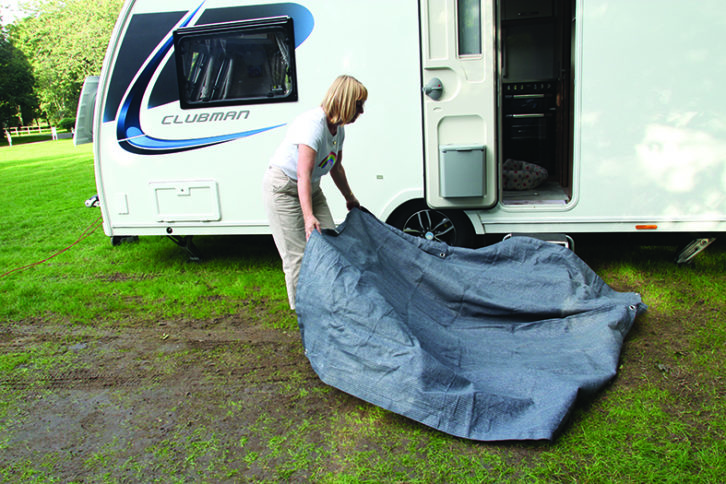
- Ideally, lay out your awning carpet or groundsheet and work on that, so that when you unbag your awning it won’t get dirty or damp on the ground.
- Air awning: Remove your awning from the bag, unroll it and place it in the correct orientation. Double-check that it’s not inside out before pulling the cord through the awning rail. It’s easy to get it wrong… and very frustrating when you have to start all over again.
- Pole awning: Unpack your poles fist (especially in poor weather) and place them in the correct layout on the floor. With practice, you might find you can part-build some pole sections before unpacking and orientating the awning material, to save a little time.
- Once the awning material is correctly positioned, find the end of the awning cord and start to feed it into the rail. Large awnings are heavy and awkward, so take your time and, ideally, have one person (the stronger, taller one) pulling the cord through the rail, and another feeding the cord smoothly into the rail.
- Awning rails are typically over eight feet off the ground, so you might need a small stepladder to reach it safely and ease the cord through. Consider keeping a lightweight ladder in one of your external lockers.
- With a full awning, the cord needs to run through the entire rail, while a porch awning only covers a section of the van side, so can be slid along the top of the awning rail until it has been correctly positioned.
- Once located in the rail, peg down the edge of the awning closest to the side of the van.
- Air awnings: Spread out the material so it isn’t tanned. Located the inflation valve (usually on the front ‘leg’), attach the pump and start pumping. Within half-a-dozen pumps, the awning will start to take shape, and within about 20 pumps it will be fully erected.
- Pole awnings: You’ll need to feed the poles into the ‘sleeves’ within the awning structure. This can be tricky, especially with larger awnings, because you need to battle your way under the material. Once you have the front section up, things get easier. Take care not to damage your tourer wall with a pole.
- With the main structure erected, it’s time to peg down the sides. This is an opportunity to get the awning shipshape, especially on uneven ground. More advanced awnings have built-0in adjustment in the poles for pitching on uneven ground.
- Now, unroll the guy ropes and peg them out, adding further tension and stability.
- Finally, it’s time to add any extras, such as protective pads, tensioning pools, inflatable supports and draught skirts, bedroom sections and so on.
- Your awning is now complete.
- To deflate an air awning, remove all ancillary parts and support beams, unpeg and roll up the guy ropes, remove the pegs, then turn the valve to the ‘deflate’ position. The air comes out quickly at first, but you will then have to roll it up to get the remaining air out of the tubes.
Top tips
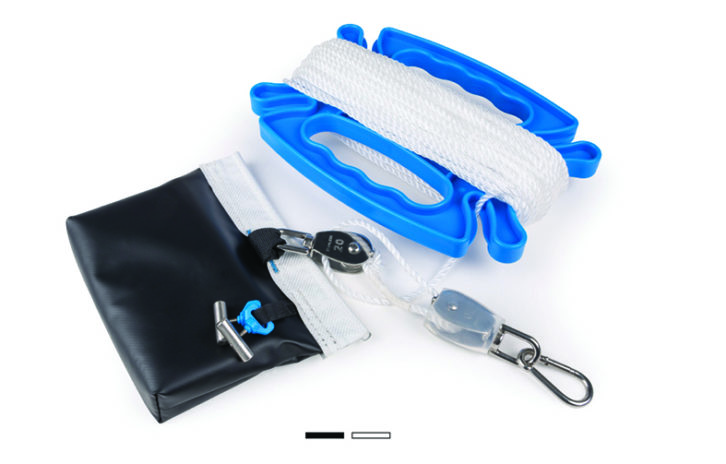
- Do a practice awning build at home, before your first holiday with a new awning. This way, you’ll know all the correct parts are included, and you’ll also know the best way to erect it.
- This is especially important if you’re likely to arrive on site in the evening. You really don’t want to be providing the night’s entertainment for your fellow caravanners!
- With some awnings, labelling your poles, for example, by colour-coding or numbering, can be very helpful, especially for occasional users. You can mark the poles when you do your first practice build.
- When packing up your awning, always aim to put it away dry. If you have to pack in the rain, or when the awning is still damp, you will need to unpack it at home and dry it properly.
- During your final days on site, if the weather looks like it might turn wet, consider taking down your awning early to avoid the hassle of drying it at home.
- Try to roll and not fold or crease your transparent awning window sections.
- Some caravanners prefer to lubricate the awning rail with silicone spray or even a slim wax candle.
- Porch awning cords can be fed into the rail through the higher access point, saving time (and bending).
- New awning users might like to watch some YouTube videos first, to get the gist of how to build efficiently.
- To save on your caravan payload, you could consider transporting heavy stuff, such as awnings, in the car.
- For solo erectors, consider buying a Kampa Easy awning Pulley. This attaches to the leading edge of the awning cord and will enable one person to pull the cord through the rail, while standing at the front of the caravan feeding the cord smoothly into the rail. There’s a good video about the on YouTube; just search ‘Kampa Easy Awning Pulley’.
- If your awning goes across a window, you will need to protect the surface of the window from abrasion. One good way to do this neatly is by sandwiching non-slip matting (available cheaply from shops including The Range and Wilko) between the plastic window and the awning edge.
- When transporting your awning gin the van, position it as near the axle as possible; the weight can be significant.
If you liked this… READ THESE:
Top gadgets for staying safe on tour
The best caravan parks in the UK 2022
If you’ve enjoyed reading this article, why not get the latest news, reviews and features delivered direct to your door or inbox every month. Take advantage of our brilliant Practical Caravan magazine SUBSCRIBERS’ OFFER and SIGN UP TO OUR NEWSLETTER for regular weekly updates on all things caravan related.
Future Publishing Limited, the publisher of practicalcaravan.com, provides the information in this article in good faith and makes no representation as to its completeness or accuracy. Individuals carrying out the instructions do so at their own risk and must exercise their independent judgement in determining the appropriateness of the advice to their circumstances. Individuals should take appropriate safety precautions and be aware of the risk of electrocution when dealing with electrical products. To the fullest extent permitted by law, neither Future nor its employees or agents shall have any liability in connection with the use of this information. You should check that any van warranty will not be affected before proceeding with DIY projects.
Awnings are available in a huge range of sizes, split into two groups: full awnings - which cover the entire side of the van while porch awnings, cover a section of the side
